| |
General Disease Management
and Goat
I. General Health management
- Before onset of breeding, problematic animals should be culled from the flock.
- Neonatal mortality can be prevented by improving the level of nutrition in advanced stages of pregnancy (last 6 weeks), ensuring hygienic condition in the kidding sheds, providing proper bedding, and ensuring early feeding of colostrums.
- Does with chronic pneumonia, mastitis, and disabling arthritis, poor body condition should be culled from the flock.
- Undernourished sheep/goats are likely to develop pregnancy toxemia and may deliver kids with poor livability. So pregnant animals should be fed with additional level of food.
- Chronic diseases in adult goats like gastrointestinal infection (Coccidiosis. Mycobacterium paratuberculosis) and gastrointestinal parasites (Haemonchus sp., tapeworm and immature amphistomes) affect the digestive tract, retard the growth, weaken the physic and stunt the animal. The affected animal act as a carrier hence should be removed from the flock.
II. Shed Hygiene
- The sheds should require seasonal spraying with disinfectants to protect the flock from ectoparasites particularly prior to kidding operation.
- The earthen floors may need replacement for every three months besides disinfection with carbolic acid, which takes care of snakes and other reptiles.
- Annual white washing with lime prior to winter may be suggested.
- Painting of sheds is recommended prior to monsoon.
- The shed area should be dry and clean and should be free from stagnated water, bushes etc.
III. Commonly used disinfectants and their usages
1. Bleaching powder (Chloride of lime)

- It can be used for disinfection of animal houses when a contagious disease has occurred and for sterilization of water supplies.
- Concentration required is not less than 30 per cent available chlorine.
- Mode of application is dusting.
- Bleaching powder must be stored in airtight bins as damp surroundings, exposure light and air causes it decompose rapidly.
2. Boric acid
- It can be used as an udder wash.
- It is a week antiseptic and is likely to harm nervous system if absorbed into body in large quantities.
- It is used as wash for eyes and other sensitive parts of body.
- Concentration required is 6 per cent solution.
- Mode of application is splashing.
- Nowadays antibiotic solutions are replacing boric acid as eyewash solution.
3. Caustic soda (Sodium hydroxide)
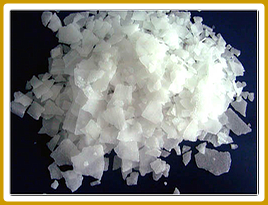
- For general use in farm buildings and animal houses, caustic soda is a very effective disinfectant as it is an excellent cleaning agent as well as a powerful germicide.
- It is highly destructive to virus of foot and mouth disease, hog cholera etc.
- It is not effective against tuberculosis and Johne’s disease organisms.
- Concentration required is 2 per cent solution for general use and 5 percent solution against spores of anthrax and black quarter.
- Mode of application is splashing.
- Rubber gloves, goggles and protective clothing should always be worn when caustic soda solution is being used as it burns skin and damages fabrics.
4. Cresols
- The cresols are only slightly soluble in water and are therefore generally emulsified with soap.
- Effective against a wide range of organisms including acid fast tuberculosis and Johne’s disease bacteria but not effective against viruses and spores.
- Good for disinfecting floors, walls, equipment etc. but not in milking barns because of its phenolic odour.
- Concentration required is 2-3 per cent.
- Mode of application is splashing.
- Use only soft water for preparing solutions, hard water precipitates soap.
- Lysol is a solution of cresol with soap.
5. Lime (Calcium Oxide, quick lime)

- It is a deodorant as well as a disinfectant.
- It can be used for sprinkling on manure and animal discharges, on floors or as a whitewash or milk of lime (also known as slacked lime).
- Mode of application is sprinkling, scrubbing or sometimes dusting.
- Always use freshly prepared lime only.
6. Phenol (Carbolic acid)

- Effective against several types of bacteria; not so effective on spores and viruses.
- Its disinfectant value is not reduced by the presence of organic matter but oil or alcohol does so.
- It is very toxic, corrosive and irritant.
- Concentration required is 1-2 per cent.
- Mode of application is splashing.
- Great care should be taken in using phenol to protect eyes, skin and clothing.
7. Quaternary Ammonium Compounds (QAC)

- These are cationic detergents.
- They have no effect on spores and viruses.
- They can be used to disinfect dairy utensils, udders, milkers’ hands and towels for wiping udders.
- Cetrimide, a white powder is an example for QAC.
- Concentration requires is 0.1 per cent solution (0.5 per cent cream for applying on teats and hands to prevent mastitis.
- Mode of application is wiping of udder with clothes wetted in 0.1 per cent solution; washing of milkers’ hands.
- Utensils should be scrubbed with boiling water before rinsing with QAC.
8. Soap

- Soap is an anionic detergent.
- It is a very week germicide.
- But its great usefulness in cleaning various surfaces including skin.
- It can be used preparatory to the application of a disinfectant.
- Mode of application is scrubbing.
- It should preferably be used only as surface-sanitizing agent.
9. Sodium hypochlorite
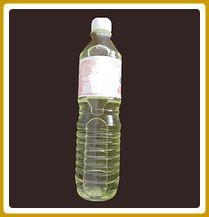
- It is a chlorine compound.
- It is an excellent disinfectant but is not effective against T.B bacteria and its effectiveness is reduced by the presence of organic matter.
- Concentration required is 200 parts per million of available chlorine about 300 ml sodium hypochlorite and about 200g of washing soda in 100 litres of hot water for washing utensils etc. For udder wash-about 60 ml in 10 litres of clean water.
- Rinsing of utensils, wiping of udder.
- Should be stored in air-tight containers as hypochlorite deteriorate rapidly when exposed to air.
10. Washing Soda (Soda ash, Sodium carbonate)

- It is good for disinfection of barn premises upon which an outbreak of virus disease like foot-and-mouth disease has occurred.
- It is a good detergent.
- Concentration required is 4 per cent solution.
- Mode of application is scrubbing.
- Lye is better against Foot-and-mouth disease virus than soda ash.
- It should be used as a hot solution.
IV. Control of internal parasites (Deworming)

- Deworming should be done at 3 months interval (yearly four times) and all the kids should be dewormed specifically for cestodiasis at 3 months of age.
- Dosing of trematode infection should be given in the post monsoon period (January to march) of every year.
- The most suitable time of deworming is the early stages of infection when the worm load is less.
- Young animals should preferably be dewormed every month using a suitable anthelmentic.
- Older stock can be dewormed at 4-6 months intervals.
- It is good to deworm adult females after parturition.
- In adult animals deworming is done on examination of dung.
- All the animals should preferably be fasted for 24 hours before giving the anthelmentic.
- Th deworming drugs should be rotated annually to avoid anthelmintic drug resistance.
- Periodical screening of individual and pooled dung samples for assessment of parasitic load should be carried out to keep the parasitic load under control.
- The local veterinarian should be consulted for all suggestions regarding dewormers and deworming.
V. External parasites control-dipping
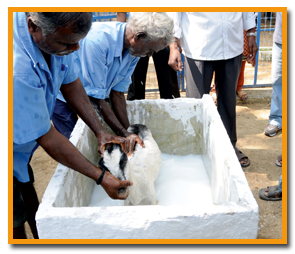
Purpose
- To remove waste materials and dung from the fleece, prior to shearing.
- To eradicate ectoparasites.
- To prevent spread of “sheep scab”
- To wart off attacks by blowflies resulting in maggots.
- Dipping is done usually twice a year i.e once before shearing and a second time when the fleece has grown long.
Precautions before dipping
- Do not dip ewes in advanced pregnancy to avoid inducing abortion.
- Always offer water before dipping so that sheep will not drink the dip.
- Always rest sheep before dipping.
- Do not dip sick animals.
- Dip about a month after shearing when the there is sufficient dip
- Dipping should preferably be completed before noon.
- Allow sheep in a draining pen for sometimes before turning them out on the pasture.
- Chooses a day is possible when the weather is not too hot.
- Dipping should be done during sunny days.
- Care should be taken to avoid contact of eyes and mouth with the solution·
- After dipping place the animal in the open place for quick drying.
Methods of Dipping
- The hand bath used for small flocks. Each sheep is lifted into the bath and turned over on its back.
- The swim bath: this is used for large flocks of sheep.
- The sheep are allowed to swim through and walk up the ramp into the drying pen.
- Sheep dips: the active agents used are
- Sulphur
- Arsenic
- D.D.T. and
- Carbolic acid etc
- The quantity of dip depends upon the length of the fleece.
Pouring
- means pouring a small quantity of dip into parts of the fleece along the back, sides and belly.
Smearing
- An ointment with a basis of tar and grease is smeared over the skin of the sheep to destroy parasites.
Crutching
- Means removing soiled and dung – stained wool by hand shears from the crutch of the sheep (perineal and inguinal regions).
Jetting
- Is a method adopted in foreign countries in which the sheep are made to run through a race or “shedder” in which is fixed a pipe which plays a jet of water into the lower part of the abdomen and the crutch.
VI. Control of arthropod pests
- Manure, filth, damp and dark corners, stagnant water etc. are all favorite breeding places of insects and these places should be concentrated for removal and cleaning periodically.
- Eggs of ticks and mites deposited in cracks and crevices in the walls, floors and wood work of the animal houses should be removed periodically.
- Periodical (once in April-June and once in July-September) dipping or spraying of animals with suitable insecticides to prevent lice, flies, fleas, mites and ticks.
- Organophosphate insecticides like Malathion, Parathion, and Neguvon etc. are available which are very destructive to insects but are quite toxic to animals as well.
- Newer generation synthetic pyrethroids like Deltamethrin (ButoxTM), Cypermethrin (Cyprol, Tikkil) etc. are available in the market.
- Great care should be taken while using these chemicals and manufacturer’s instructions regarding their usage should be scrupulously followed.
VII. Prevention of infection and infestation
- Feed should be placed in troughs that cannot be contaminated by faeces.
- Waterers and feed troughs should be kept clean and free of contaminants.
- Good grazing management to control pasture or grassland borne helminthic infections.
- Use of clean or safe pastures (not grazed for 6 to 12 months) will help to control helminths problems.
- Rotational grazing of livestock species should be followed to minimize or limit the infection from pasture.
- All new arrivals to the farm should be isolated for at least 30 days and dewormed.
- Young animals should be housed separately from adult animals to prevent disease spread.
- Infected/Infested animals should be removed from the flock or herd and housed separately.
- Treatment should be followed by chemoprophylaxis to prevent reinfection.
- Vaccines may be used to prevent infection, if suitable vaccines are available.
VIII. Vaccination schedule for sheep and goat
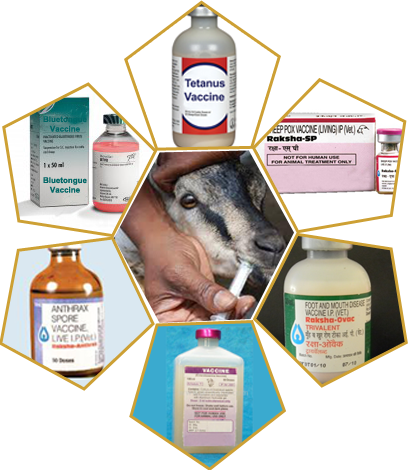
|
Disease |
Vaccine |
Tetanus |
Within 48 hrs after birth |
FMD |
2nd month of age repeated once in 6 months. |
Sheep and goat pox |
6 months of age repeated annually, vaccination in endemic area. |
Anthrax |
6 months of age repeated annually, vaccination in endemic area. |
Enterotoxaemia |
6 months of age repeated annually, vaccination should be completed before onset of monsoon. |
PPR |
6 months of age repeated annually, vaccination in endemic area. |
Blue tongue |
6 months of age, repeated annually. |
IX. How to control and reduce the infection as soon as an outbreak occurs
- Segregate sick animals.
- Stop all animals, animal products, vehicles and persons coming into and out of the farm.
- Call a veterinarian for advice, adopt containment vaccination.
- Avoid grazing in a common place.
- Ban all visitors to the farm.
- Provide foot dips containing disinfectants at the entry of the farm and gear up sanitation and hygiene.
X. Hoof trimming
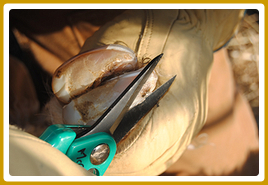
- If the animals are maintained under intensive system of management their hooves have to be trimmed regularly.
- Feet that are not kept properly trimmed can became deformed and may cause lameness and it will affect the performance of the animals.
- An adequate care should be taken while trimming the hoof.
- Cut the hoof once in six months.
- First cut off any bent over portion of the hoof.
- Then cut from the heel towards the toe.
- When you see pink colouration, this means you are nearing the blood supply and should not go any deeper.
XI. Footbath

- A footbath made of galvanized steel sheets, or brick in cement mortar shall be provided at the entrance to the yard to protect the animals from foot-rot disease.
- These baths may be embedded in the soil suitably.
TOP |











